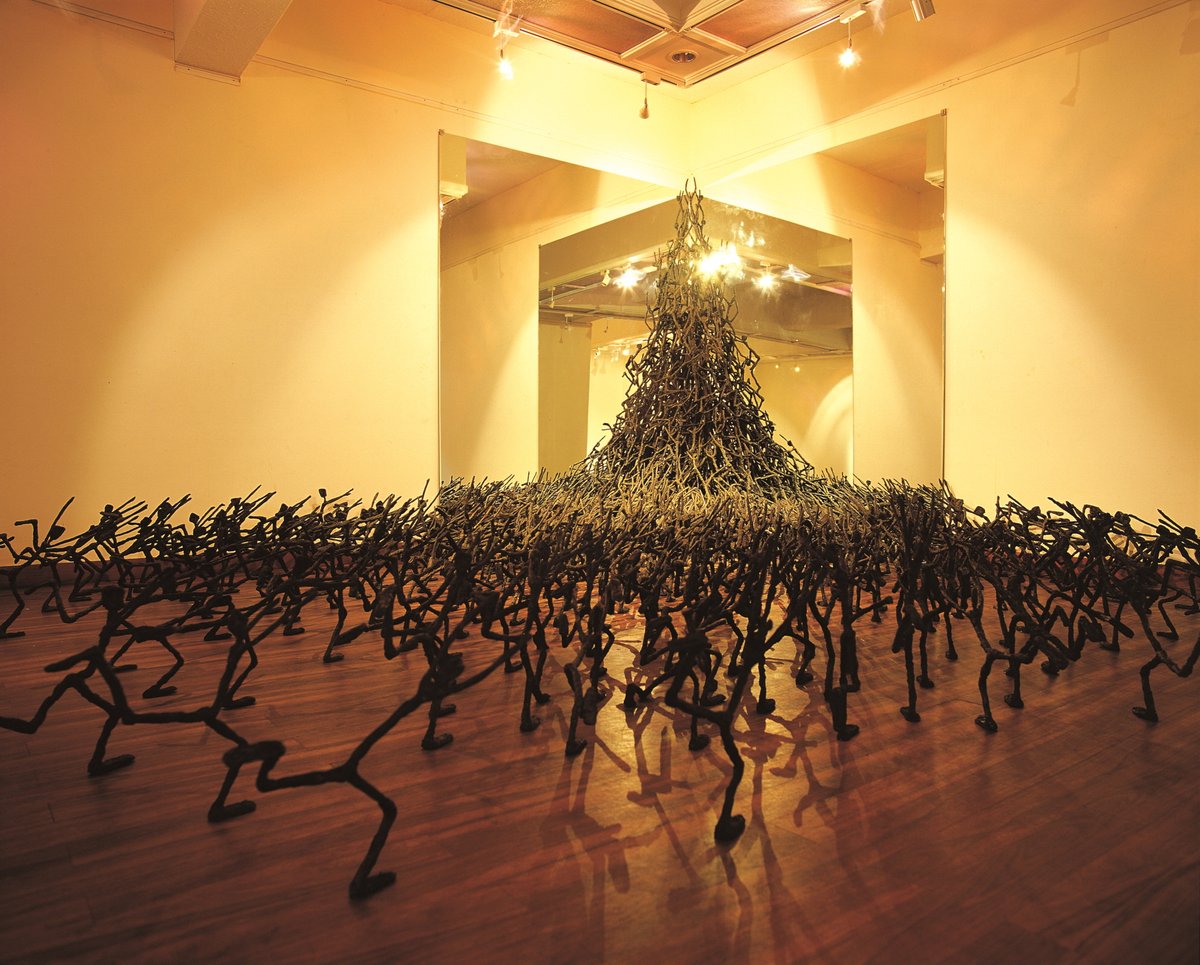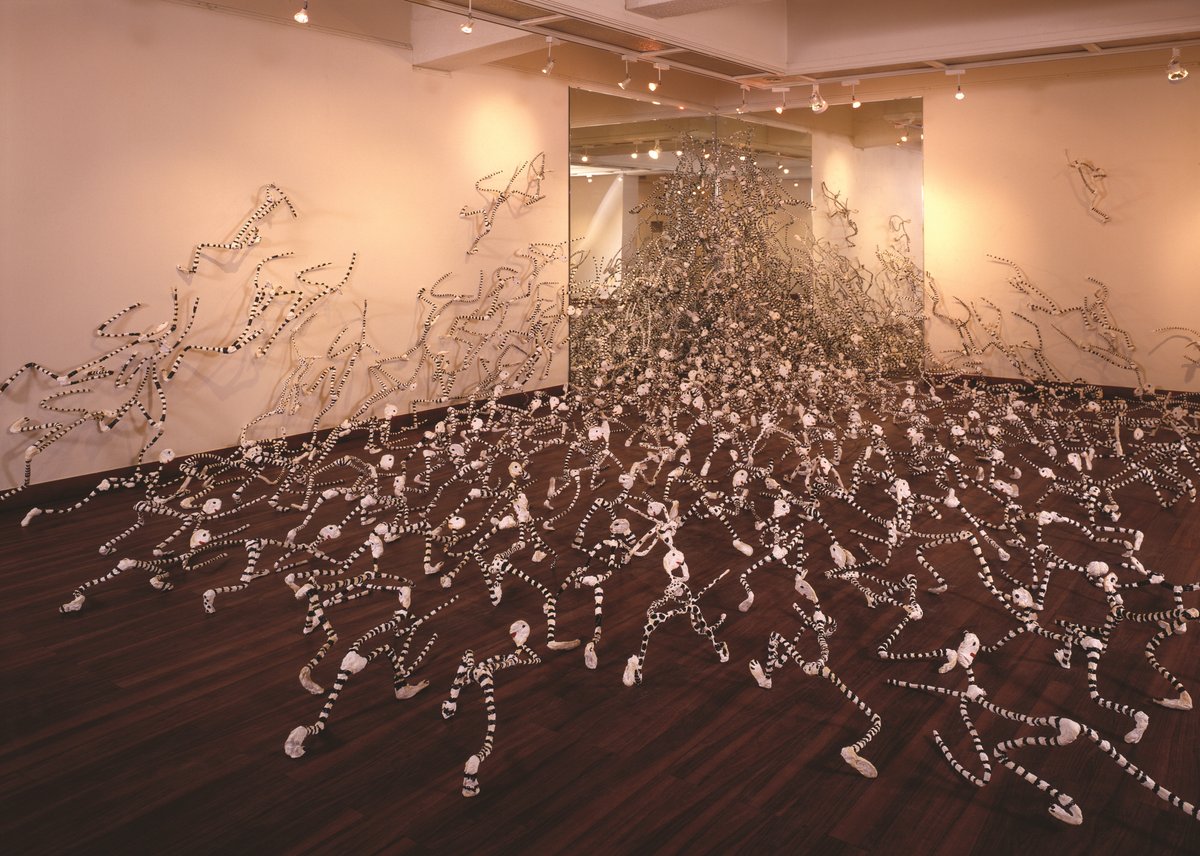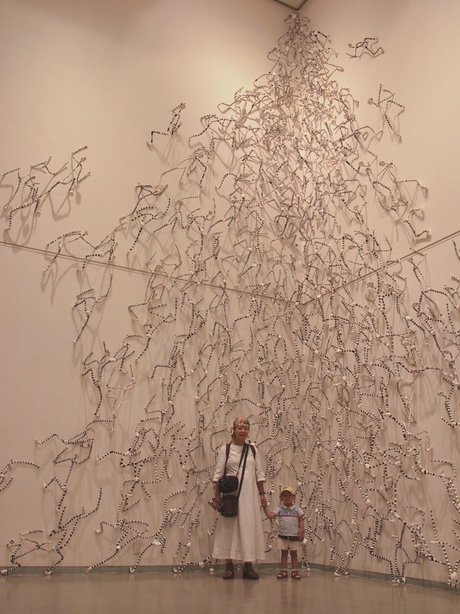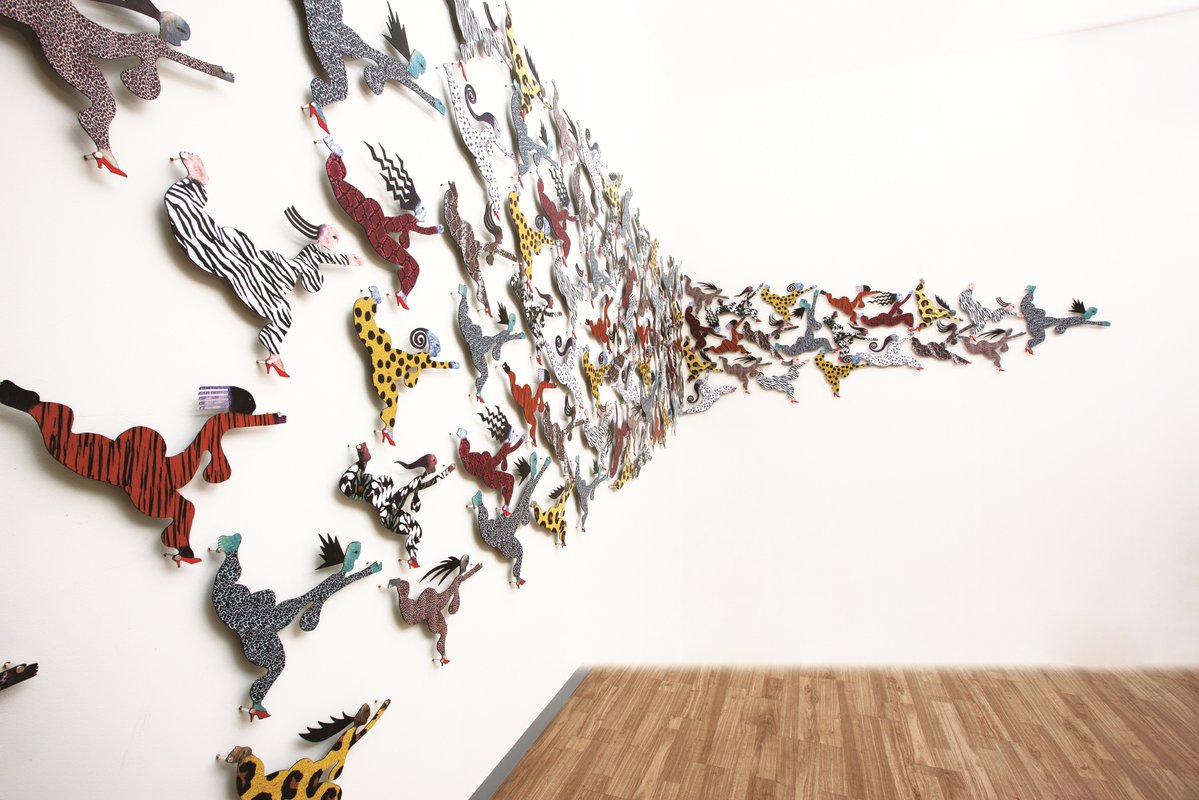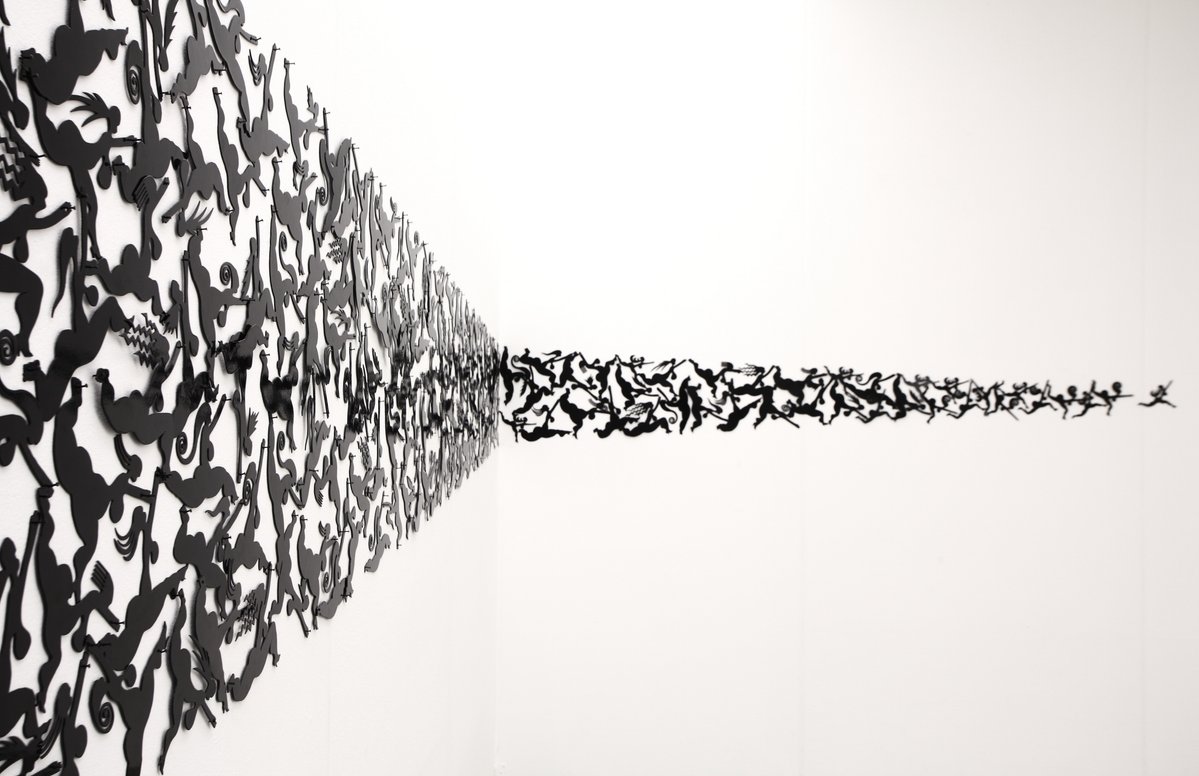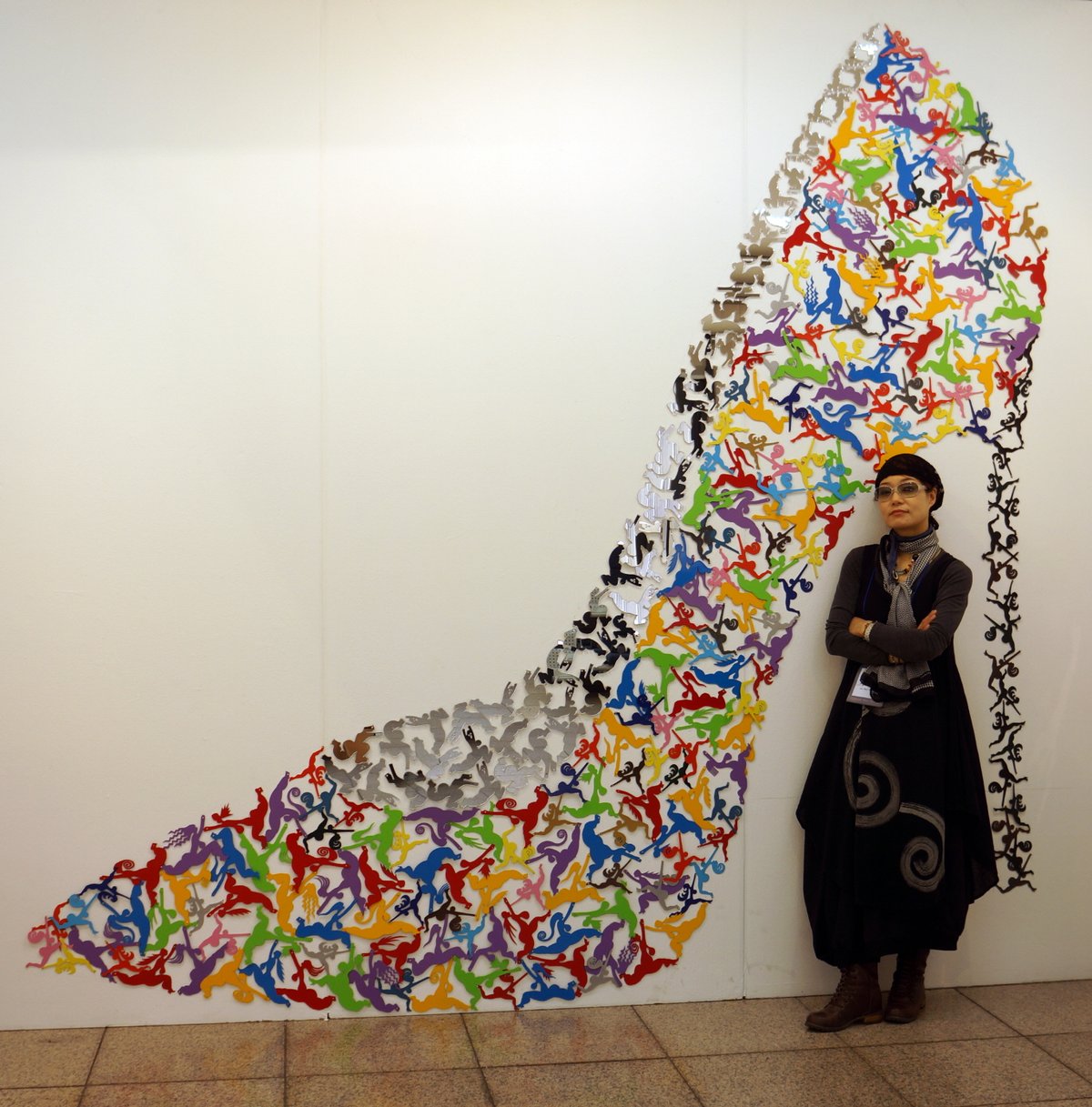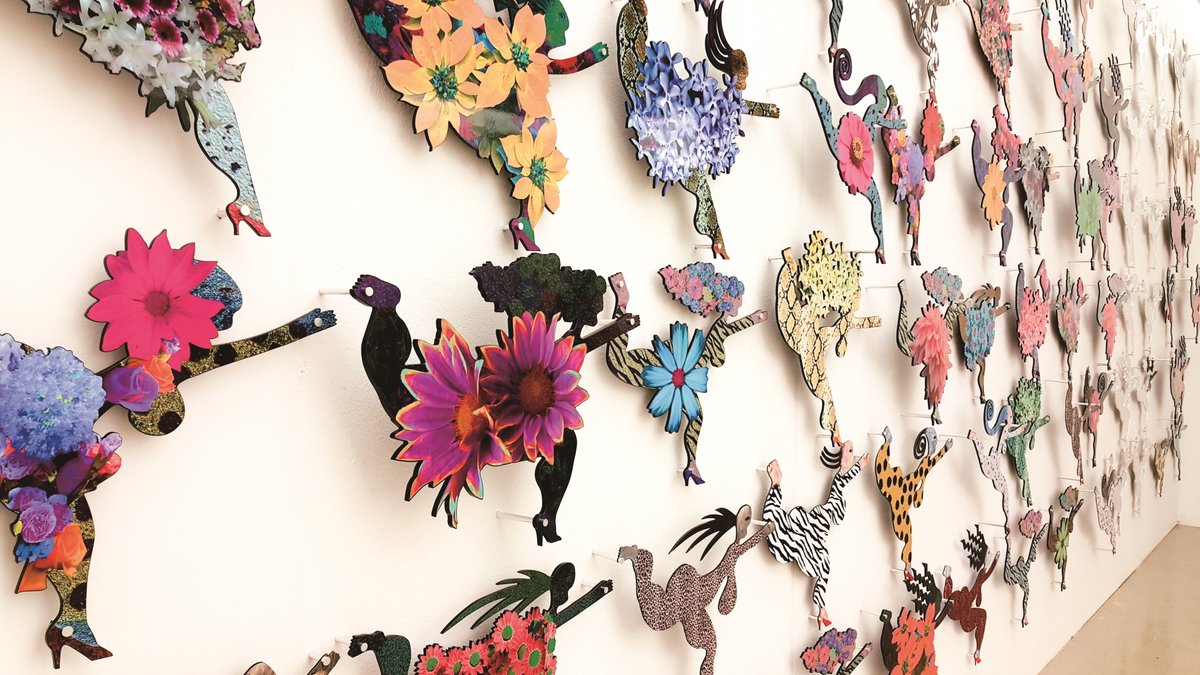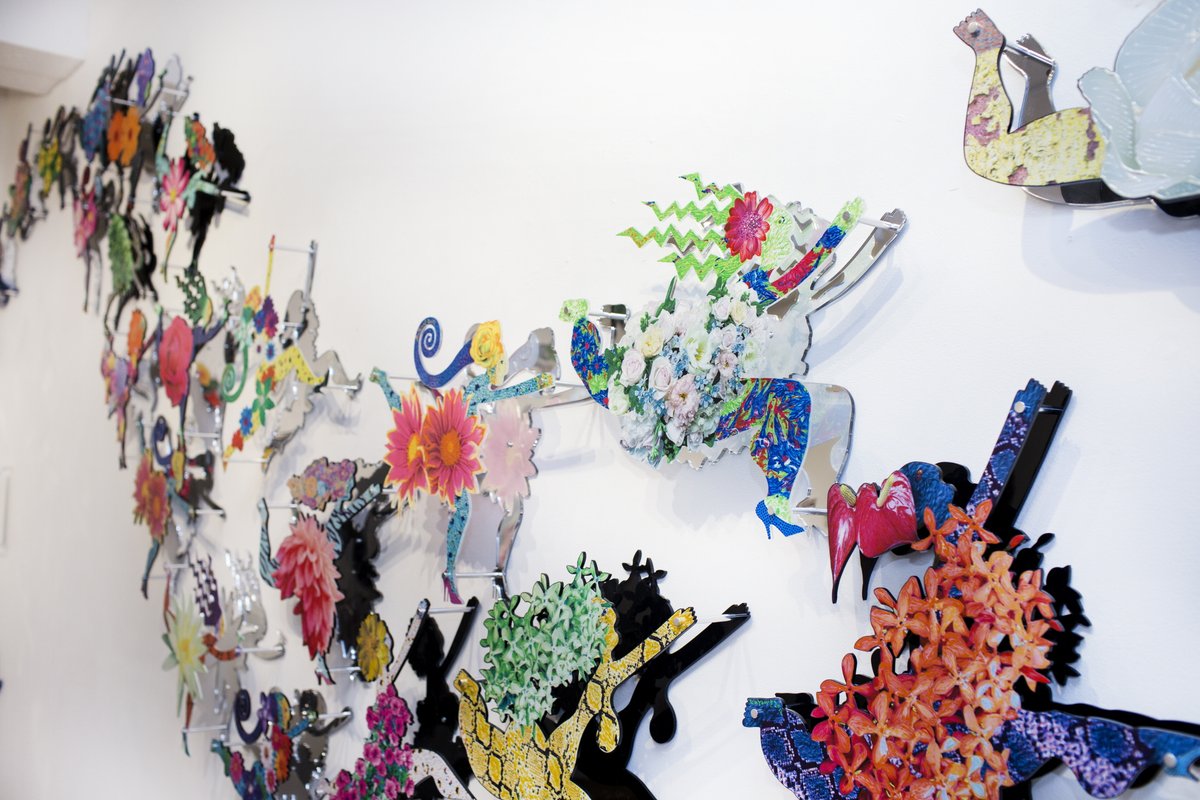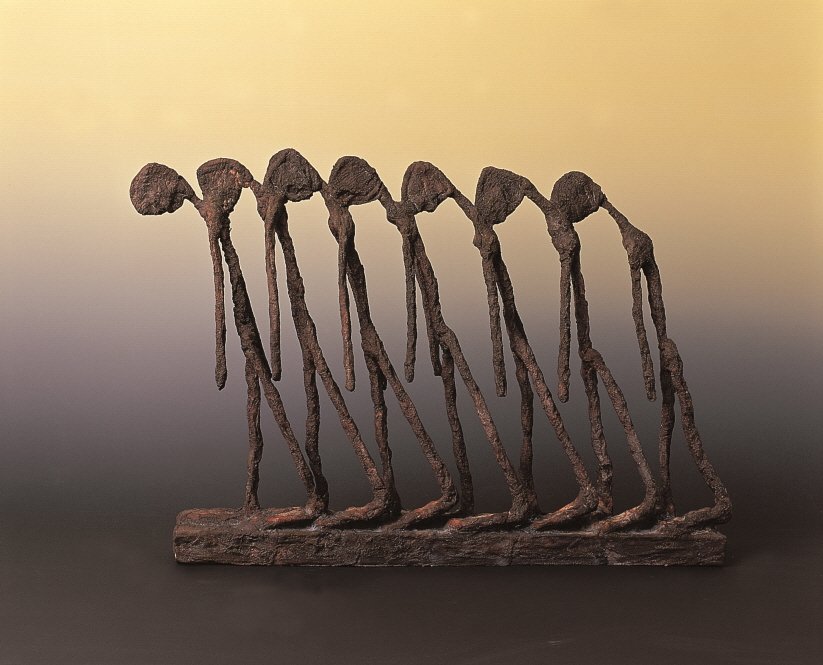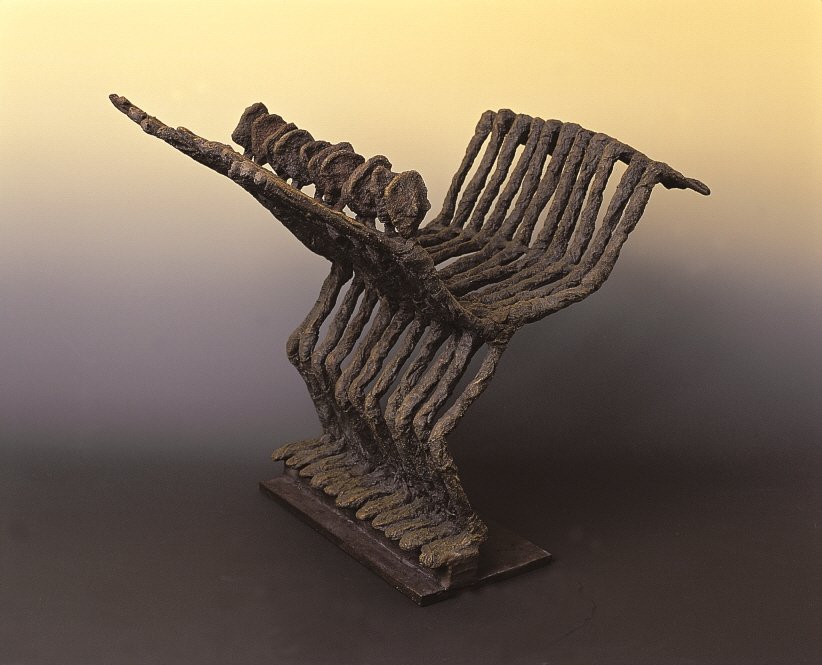조각가 인명사전
- HOME
- 조각가 인명사전
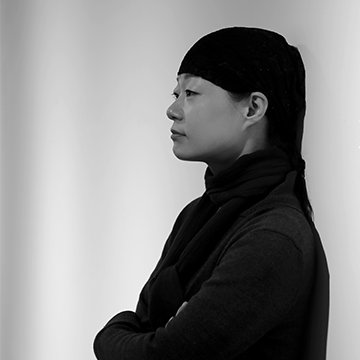
주라영
작가 작품
작가 프로필
작가 노트
Here & Now – 마음의 감옥
빠삐용처럼 마치 죄수의 옷을 입고 있는 듯 동물처럼 변형되고 기형화 된 500여명의 인간 군상들이 하나의 목표점을 향하며 어슬렁어슬렁 기어가고 있다.
이 세상은 감옥을 상징하며 그들이 출구라고 생각하고 향하는 곳 또한 감옥이다.
왜냐하면 이 세상은 그들의 마음이 만들어 낸 형상에 불구하며 그 출구 또한 마음이 만들어 낸 허상이기 때문이다.
우리는 그 감옥 안에서 해방되기를 꿈꾸지만 출구를 찾지 못하고 방황한다.
마치 파충류와 같은 모습을 한 인간이 입을 공허하게 벌린 채 어슬렁어슬렁 기어가고 있다. 줄무늬는 파충류의 무늬를 떠올리게도 하지만 한편으로는 광대의 모습을 연상케 한다.
감추고 싶은 인간의 내면에 있는 동물적 근성을 상징적으로 조형화시켜 그것을 바라보는 관객에게 마치 숨기고 싶었던 비밀 하나를 들킨 듯 웃음을 자아내게 하는 해학적 요소가 있다.
작품 안에서의 해학성의 의미는 대중과 예술의 거리를 좁혀주는 역할을 한다.
쓴웃음이든 단 웃음이든 관객의 감정적 요소를 건들임으로써 관객은 작품에 한 발작 다가서게 되는 것이다.
그리고 예술을 통한 감성 카타르시스를 경험했다는 성취감을 맛본다.
그렇게 되면 소통의 문은 쉽게 열리고 작가는 좀 더 가벼운 마음으로 자신의 목소리를 들려줄 수 있게 된다.
그래서 나는 앞으로도 작품 안에서 해학성을 배제하지 않을 것이며, 그 해학적 요인은 대중과의 소통에 있어서 중요한 매개 역할을 할 것이라 믿는다.
또한 나의 작품은 시대 풍자적 요소를 띤다.
예술가가 시대를 조형언어로 해석한다는 것은 누구나 아는 사실이다. 나는 그 해석에 현대인의 욕망의 극한을 적나라하게 보여줌으로써 현 사회를 마치 비웃기라도 한 듯 풍자한다.
이 풍자적 요소는 보는 이로 하여금 반감을 갖게 하고, 결국 그 반감은 자신도 모르게 반성으로 돌변하게 하는 힘을 지닌다.
그래서 그 풍자적 요소를 작품에 적극 반영하여 내면의 성찰로 전향하게 할 것이다.
Here & Now – Prison of Mind
They are deformed 500 people who are wearing prisoners clothing like Papillon were transformed into animals, crawling slowly towards the same direction to reach a goal.
The world symbolizes prison and the exit that people think and going to is a prison as well.
That is because although this world is a feature created by their minds that exit is also created by their illusions as well.
Although we dream of being free from that prison, we can't find the exit and we wander. This reptile like human is crawling slowly with his mouth open. These stripe patterns not only make us think of reptiles but also remind us the figure of a clown.
I made a symbol of an animal feature that we wanted to hide inside of us then add a humorous factor which made the people who see my work smile like as if their secret was discovered.
The meaning of this humor in my works is to make people and art closer. Whether is it bitter smile or sweet smile, I manage to touch people's emotion which bring them one step closer to art.
They could experience the achievement of emotional catharsis through art. By means of art, the door to communication is easily opened and the artist can deliver his message easily. So I always add some humor effect to my work and I believe that it plays an important role to communicate with people.
In addition to that, my art also has satire of time. Everybody knows that an artist should translate time into visual formal language. I demonstrate modern people’s desire and society through it as if I mocked.. It seems like good or bad emotion satire effect. Those people could feel good or bad emotions as they see my work then they would turn back to reflect.
So the satire effect is applied and converted for self-reflection.
Beyond Here & now
우리가 바라보는 세상은 홀로그램 이미지일 뿐이다!
자아조차 망각한 채 맹목적으로 정신없이 앞으로만 내달려야 하는 현대인의 불안,
오로지 살아남기 위해 허덕거리며 질주할 수 밖에 없는 현대인의 모습은 가엾은 우리시대의 초상이다.
나는 누구인가? 나는 어디로 가고 있으며, 나는 어떻게 살고 있는가를 관객 스스로에게 반문하게 하며, 해학적 메시지를 통해 궁극의 질문을 던지는 작업이다.
하이힐은 삶에 추동하게 하고 나라는 존재에 집착하게 하는 욕망을 상징한다. 인간은 과거, 현재, 미래라는 시간과 여기와 저기가 교차하는 공간 속에 사는 실재라고 여기는 존재론적 사고의 틀 안에서 살고 있다.
"Beyond Here & Now"는 그 삶의 속도를 다양한 모습으로 달려가는 형상을 통하여 표현하였다. 개개인의 삶의 호흡에 맞는 색의 옷을 입고, 입을 벌리고 공포에 질린 듯, 손의 기능을 상실한 양 팔은 무언가 붙잡을 듯한 모습으로 힘없이 앞으로 뻗어 있다. 팔이 기형적으로 길어지거나, 목만 비례에 맞지 않게 길어져 있거나, 또는 다리 한쪽이 비정형적으로 개개인 각자의 몸의 자동화 된 습관을 상징하며 길어져 있으며, 맹목적으로 뛰어가는 사람들의 표정은 공허할 뿐이다.
왜냐하면 이 세상은 각자 자신의 인식프로그램이 만들어 낸 홀로그램적인 세상의 전개일 뿐! 실재로서는 존재하지 않는 허상이기 때문이다. 그래서 굉장히 무겁고 육감적인 형태를 한 사람들이 비현실적으로 마치 연기처럼 하이힐을 신고 가볍게 날듯 뛰어가게 디자인하였다.
벽에 디자인 된 하트나 큐브, 하이힐 등의 이미지는 우리 인식이 만들어 낸 실재가 아닌 허상의 홀로그램 정보를 상징한다. 멀리서 바라보면 우리가 머릿속으로 떠올리는 정보화된 이미지를 볼 수 있지만 가까이 들여다보면 다양한 색의 옷을 입고 하이힐을 신고 달려가는 사람들이 밀집되어 있다. 이것은 존재론적 삶으로 추동하는 인간의 욕망이 각자 그들만의 이미지를 만들어 내어 진정한 소통에 장애를 일으키는 인식의 감옥을 상징하며, 인간은 각자가 만들어낸 인식의 감옥에서 살고 있음을 의미한다.
이 인식의 감옥은 하나의 이미지 안에 사람들을 가득 채워 놓는 방법으로 설치하여 표현되었으며, 그 인식의 감옥 밖으로 탈출하는 역할은 관객의 몫이다. 전시기간 중 매일 관객이 각자가 선택한 캐릭터 하나를 떼어 내어 해체시킴으로써 우리인식이 만들어 낸 허상의 이미지 하나가 사라진다. 그리고 전시기간 중 조금씩 해체되어 전시가 끝나면 처음 그 이미지가 생겨나기 이전의 텅 비어 있던 공간으로 다시 돌아가며, 가짜 이미지가 해체되어지는 전 과정을 지켜볼 수 있다.
본 작업은 인간의 욕망으로 가득 채워놓은 이미지를 관객 스스로가 참여하여 해체시켜야만 완성되는 설치 작업이며, 관객 스스로가 세상이 만들어 놓은 또는 각자의 삶의 정보가 만들어낸 허구적 이미지에서 자기 본성을 회복하는 메시지가 있다.
- 작가노트 중...2011
Beyond Here & now
The world we see is just hologram image!
Modern people who have anxiety and are overtasked to survive are just the portrait of our times.
To where I go and how I live are the ultimate questions through humorous message to the audience.
High heels symbolize human desires to drive life and have obsession over self. Human beings live within the framework of existential thinking, meaning that they are entities living in the intersection between the time of past, present and future and the space of here and now.
"Beyond Here & Now" expresses the speed of life in a variety of running shapes. Shapes wearing the clothes of color fitting to the breath of individual life, opening the mouth in fear, and with both arms losing their functions are depicted. Abnormally long arm and neck or atypical length of one leg stand for automated habit of an individual and blindly running people's expressions look empty because this world is just the development of hologram world created by one's own recognition program and it is illusion which doesn't exist in reality. So people of extremely heavy and sensual shape are designed as if they put on high heels and run lightly.
The images of heart, cube and high heel designed on the wall are not entities created by our recognition but stand for the hologram information of illusion. Seen from distance, we can see information image occurring to our mind, but looking into them closely, you can see the people who wear the dress of the various colors and run on high heels are crowded. It symbolizes the prison of cognition that human desires operated as the existential life created their own image and cause disorders of true communication and human beings live in the prison of cognition they created.
Such a prison of cognition is expressed by filling people within an image and escape from this prison is up to you. During the period of exhibition, visitors detach a character chosen by them and the image of illusion created by our cognition disappears. After exhibition, the space becomes empty again and you can observe the whole process of dissolution of a fake image.
This work is installation completed by inducing visitors to take part in dissolving image filled with human desires and has the massage to recover their nature from a fake image made by life information or by the world.
- artist note...2011
BEYOND HERE & NOW-인식의 감옥
우리가 바라보는 세상은 각자의 삶의 인식 시스템에 의하여 저장된 정보의 투영이다.
나의 인식의 변화에 따라 대상은 달라진다. 그러므로 세상은 내가 대상을 어떻게 인식하고 있느냐에 따라 바뀐다. 경험의 정보로 투영된 홀리스틱holistic한 정보의 결합체인 대상에 우리는 이름과 개념, 의미, 가치를 부여하고 살아간다.
인간은 존재론적 삶으로 추동하는 욕망으로 각자 그들만의 이미지를 만들어 내어 진정한 소통을 하지 못하고, 각자가 만들어낸 인식의 감옥에서 살고 있다.
삶은 찬란하게 피었다 떨어지는 한 떨기 꽃과 같다.
그러나 우리는 각자의 삶의 호흡에 맞는 패턴화 된 화려한 무늬의 옷을 입고, 공포에 질린 듯한 표정으로 도망치듯 어디론가 하염없이 달려간다. 문명의 이기로 손의 기능을 상실한 양 팔은 무언가 붙잡을 듯한 모습으로 힘없이 앞으로 뻗어 있다. 몸은 각자의 자동화 된 습관을 상징하며 변형되었으며, 맹목적으로 뛰어가는 사람들의 표정은 공허할 뿐이다. 왜냐하면 이 세상은 각자 자신의 인식프로그램이 만들어 낸 홀로그램 영상일 뿐! 실제로 존재하지 않는 허상이기 때문이다.
굉장히 무겁고 육감적인 형태를 한 사람들이 비현실적으로 마치 깃털처럼 하이힐을 신고 가볍게 날듯 뛰어가게 연출하였다.
- 작가노트 중...2015
BEYOND HERE & NOW-Cell of Cognition
The world we see is the projection of information saved by recognition system of our own life. The object varies depending on the change of my cognition. Therefore, the world is varied by how I recognize an object. The object of recognition is just the combination of holistic information projected by my experience and the production of a visible hologram image. We call the assembly of such an information of life and live with misconception.
It symbolizes the prison of cognition that human desires operated as the existential life created their own image and cause disorders of true communication and human beings live in the prison of cognition they created.
Life is just a bunch of flowers.
The speed of the life is expressed through the shape running into the various aspects. Characters wear the dress with patterned design suited to individual life and arms losing the functions of hands stretched forward powerlessly. Expression of the people who run blindly is empty because this world is just hologram image made by our own recognition program and it is virtual image.
So people with extremely heavy and sensual impression are produced as if they put on high heels unrealistically and run like flying.
- artist note...2015
평론
질문하는 작품
설치미술은 공간을 점유하는 예술이다. 상식적인 시공간을 전복시키는 힘을 발휘하여 관객의 시선 뿐 아니라, 오감영역에 말을 걸어온다. 공간을 바꾼다는 것은 환경의 변화이고, 시공간의 변화를 말한다. 이쁘게 꾸미거나 기능을 제공하는 인테리어, 혹은 리모델링 등 상업적인 컨셉으로 대부분 공간 작업을 하지만, 현대미술가들이 공간을 점유하는 설치미술은 전혀 다른 작업이다. 공간과 사물이 괴팍하게 소리지를 수 있고, 공간과 사물이 고요한 세계로 안내할 수도 있다. 공간의 비일상성의 충격은 작가만의 방식으로 세상에 소통을 시도하는 것이다.
주라영 작가의 설치작품은 거대한 스케일로 작품 속으로 들어온 사람들에게 삶의 근원적인 질문을 한다.
나는 작가의 삶에 대한 질문 앞에서 걸음을 멈추었고, 여러 사람이 그 질문 앞에서 멈추었다. 작품 앞에서 '멈춤'이 일어난 것이다. 멈춤은 그동안 믿어왔고 욕망했던 어떤 것에 대한 멈춤일 수도 있고, 이 무모하리만큼 반복적으로 손으로 작업했을 수천 개의 달려가는 군상 속에서 멈춤이 일어날 수도 있다.
2003년, 한 방향으로 서로를 밟고 달려가는 2000여 점의 반복적인 인간 군상 속에서 멈춤이 일어났던 기억이 있다. 그 작품의 제목은 Here & now였다.
작가는 작품으로 현대인에게 삶에 대해 묻고 있다. 작품을 보고 멈춤의 순간이 찾아온 관객들은 내면에서 밀고 올라오는 어떤 질문과 마주하게 되었을 것이다.
'달려가는 사람들' 시리즈로 개인전에서 보여준 작가의 질문은 욕망에 추동되는 인간 군상을 통해 현대인의 삶을 돌아보게 하였다.
'나는 저렇게 한 방향으로 욕망에 추동되어 생각없이 달리고 있는 인간은 아닌가?'
'이렇게 사는 것이 인간다운 삶인가?' ...
2000명의 군상이 한 방향으로 달리고 있는 Here & now '달려가는 사람들' 시리즈는 그 군상을 관객들이 한 점에 3만원에 사서 가져가면, 해체되는 것을 컨셉으로 전시가 진행되었다. 물론 해체되진 않았지만, 무모하게 보일정도로 수천 개의 달려가는 사람들을 만들고 있었을 작가를 생각해보면, 그 집중력과 집요함이 순수열정이 아니면 할 수 없는 일이라는 생각이 든다.
그 엄청난 양의 달려가는 사람들이 설치된 충격적인 전시회는 우리 사회에 이슈를 만들었고, 그 작품은 중등미술교과서에 나오게 되었다.
주라영 작가는 인간의 욕망과 관련된 인간군상을 설치미술로 보여주고 해체시키는 작업을 변화를 모색하며 꾸준히 진행해 오고 있다.
인간이 이성을 잃고 맹목적으로 내달리면, 집단 이념에 갇히게 되기에 그것을 해체시키는 주체가 관람자가 되도록 한 ‘Here & now’의 주제에서 ‘Beyond here & now’로 새로운 사고의 전환을 보여준다.
달려가는 사람들의 개체에 컬러플한 욕망의 문양을 넣어 다양한 캐릭터들이 벽을 타고 달려가는 설치 작품이다. 동물들의 문양이나 장식적인 패턴의 이 강렬한 캐릭터들은 이제 꽃으로 바뀌어서 달려가고 있다.
‘Beyond here & now’의 주제는 달려가는 사람들이 화려한 옷을 입고 등장했다. 개체의 캐릭터가 컬러플하게 등장하며, 그것들이 모여 다시 큰 이미지를 만들어 내고 있다. 그러나 그 이미지도 낱개 낱개 관객들이 가져가면서 해체되는 과정이 주라영작가의 중요한 컨셉이다.
물론, 전시회를 할 때마다 해체되지는 못했지만, 작가는 그 개념화된 이미지의 덩어리를 해체시키는 것을 늘 전시회의 과정이라고 말한다. 즉 ‘Beyond here & now’는 우리가 만들어낸 물질과 이미지는 물론 개념이 허상임을 말한다.
작가가 일상에서 만난 찬란하게 아름다운 장면들이 달려가는 사람들의 패턴이 되면서 화려한 장식성이 강조되고 있는데, 그 화려함이 그로테스크하다.
'우리의 삶이 꽃 피고 지듯, 그렇게 일어났다 사라지고, 찰나생 찰나멸 하는 게 아니겠습니까?'라고 그 화려한 작품으로 또 질문을 던진다.
작가는 답을 주지 않는다.
관객이 스스로 멈추어서 그 답을 찾도록 작가는 작품으로 ‘삶이 무엇이냐고’ 집요하게 질문한다.
메이홀 큐레이터, 예술치료학박사 주 홍
A Work that Questions
Installation art is art that occupies space. By subverting the common-sense perspective of space and time, it not only speaks to the viewer’s eyes, but to all of the five senses. Transforming the space is a change in both environment and space and time. Although such work as decorating, functional interior design, or remodeling is, as a commercial concept, mostly space-related work, it is entirely different work from contemporary artists’ space-occupying installation art. As the space and object may shout eccentrically, the space and object may also guide us into a tranquil world. The space’s jolt of non-everyday life is the artists’ own attempt to communicate with the world.
With their enormous scale, the installation works of Ju Rayoung ask fundamental life questions of those who are into her works.
I halted my step in front of the artist’s question on life, and all the other people also stood still in front of it. A ‘halt’ has occurred in front of the work. It could have occurred from something you have believed or desired, or made from a crowd of thousands of moving sculptures, which were daringly attempted through repetitive handcrafts. I recall a halt from 2003, in front of a crowd of two thousand repetitive human sculptures, dashing over each other in the same direction. The title of the work was “Here & Now.
Through her work, the artist asks modern people questions about life. Looking at the work, the audience members who experienced a halt must have faced a question arising internally.
The artist’s question, displayed in the solo exhibition of the “Running People”series, has asked modern people to look back on their lives through groups of sculptures.
“Am I a person running thoughtlessly in one direction, driven by desire?”
“Is this the true life of a human being?”
The “Here & Now” Running People series, a crowd of two thousand sculptures running in one direction, was an exhibition with the concept of the crowd being dismantled, upon the audiences’ purchasing of each sculpture at 30,000 won. Of course, although it was not dismantled, if you can imagine the daring scene of the artist sculpting thousands of running people, this concentration and persistence would not have been possible without pure passion towards her work.
This staggering installation, with an enormous crowd of people running, has created issues in our society, and the work was even included in middle school art textbooks.
Rayoung continuously adds varieties into her practices, installing and dismantling human-figured sculptures involving human desire. The new theme, “Beyond Here & Now,” presents a change in mindset from the previous theme “Here & now,” which allowed the audience to be the subject of dismantling the confined communal ideology made when a man loses his rationality and drives in blind.
It is an installation work consisting of each individual runner’s colorful patterns of desire, with various characters running along the wall. These vividly colorful characters, in animal designs or decorative patterns, have now turned into a racing flower.
The theme of “Beyond Here & Now” appeared with people running, dressed in vibrant colors. Each individual character appears in a carnival of colors, and then they form a large image by gathering together. However, the process of the audience members dismantling the image piece by piece is the most significant concept in the artist’s work.
Of course, though it has never been dismantled during the exhibition, she maintains that dismantling the cluster of conceptualized images has always been part of the exhibition process. In other words, “Beyond Here & Now” proves that all materials, images and even concepts created by humans are a bunch of illusions.
The gloriously beautiful scenes of the artist’s daily encounters are presented in patterns of people dashing, and its splendid decorative features are emphasized, arousing a sense of grotesque brilliance. This brilliant work throws out yet another question, “Just as flowers bloom and fall, are not our lives coming and going, with one replacing another?”
The artist does not give an answer.
By asking them to halt and seek for the answer through her work, she persistently asks the audience “what is life.”
Curator, May Hall
Ph.D. in Art Therapy
Joo Hong
맹목의 질주, 맹목의 탑
최태만(미술평론가)
주라영의 작품은 획일화가 가져오는 끔찍한 자아상실의 현장을 보여준다. 그녀의 작품 속에서 몰개성하고 익명적인 사람들은 오로지 한 곳만을 향해 전력질주하고 있다. 그들의 목적지는 불투명하지만 어쨌든 한 방향으로 향하고 있다. 이 맹목의 질주가 의미하는 것은 무엇일까.
그들은 권력의 탑을 쌓고 있는 것일까. 바벨탑처럼 필연적으로 무너질 수밖에 없는 목표를 향한 부질없는 노고(勞苦)에 헌신하려는 것인가, 아니면 숭배자에 대한 일방적이고 단호한 복종의 의지를 담은 질주인가. 넘어지고 자빠지는 한이 있더라도 오로지 한 곳을 향해 내달리고 있는 그들의 질주는 과연 신앙에 가깝다. 바벨탑을 쌓았던 사람들은 신에 보다 가까이 다가가고자 하는 목표가 있었다. 그러나 이들의 질주는 왠지 맹목적이다. 아마 처음에는 분명한 이유와 뚜렷한 목표가 있었을 것이다. 그러나 달리는 과정에서 그것은 망각되고 오직 한 곳으로 향해 달리는 일 자체가 목적이 되어버린 듯 하다. 여기에서 기묘한 집단최면과도 같은 것이 발생한다.
사실, 집단최면은 회화의 훌륭한 주제 중 하나이기도 했다. 1808년부터 1810년 사이에 고야(Francisco Goya)가 그린 <거인>은 인간의 운명을 좌지우지할 수 있는 거인이 버티고 있음에도 불구하고 우매한 인간들이 서로 살육의 축제를 벌이고 있는 장면을 보여주고 있다. 이러한 집단광기, 카프리쵸스(caprichos), 마술적 상상력을 자극하는 이미지는 고야보다 약 삼백 년 전에 플랑드르에서 활동했던 보슈(Hieronymus Bosch)가 약 1500년경 그렸던 <쾌락의 정원>이란 삼면화의 가운데 부분에 나타나고 있는 인간들의 애매한 행위에서도 발견할 수 있다. 쾌락, 도착, 집단최면과도 같은 몰아지경에로의 몰입은 특히 낭만주의 회화에서 발견할 수 있는 특징이기도 하다.
고야의 그림에서 마녀의 집회에 모인 사람들의 휑한 눈을 통해 시대의 불안을 읽을 수 있고, 소경의 지팡이를 잡고 뒤따르던 소경들이 연달아 도랑에 처박히는 가련한 모습을 그린 보슈의 그림에서 인간의 우매함이 낳은 비극을 엿볼 수 있는 것처럼 주라영의 질주하는 사람들의 모습을 통해 자아조차 망각한 채 정신없이 앞으로만 내달려야 하는 현대인들의 불안을 발견할 수 있다. 이들은 소경도, 마녀의 최면에 걸린 심약한 신도들도 아니다. 이들은 일상적으로 전력질주를 강요받고 있는, 그것도 제동장치가 파열된 폭주기관차처럼 오로지 살아남기 위해 허덕거려야 하는 현대인들의 모습을 보여주고 있는 것이다. 그런 점에서 이 집단최면에 빠진 인간들의 형상에 대해 현대인의 초상으로 불러도 무방할 것이다.
애초에 작가는 전시기간 동안 방문자들에게 이천 개에 이르는 이 인간의 형상을 나눠주기로 했다. 그의 이러한 의도는 이 인간의 형상이 현대인의 초상이란 심증을 더욱 굳히게 만든다. 비록 무료로 나눠주기보다 거의 원가에 해당하는 가격으로 판매하는 것으로 계획을 바꿨다고 하더라도 이것을 분산시킴으로써 전시는 완결된다. 즉 집단을 흩뜨려 놓는 것이다. 매일 조금씩 사라지고 있는 사람의 형상들을 기록하겠다는 작가의 의도는 집단, 조직, 규율 속에 소속될 때 비로소 심리적 위안을 느끼고 안심하는 현대인들의 소심함을 향해 던지는 통쾌한 일탈의 외침일 수 있다. 결국 전시장은 텅 비어야 한다. 그것은 소속감의 해체를 조장하려는 것이 아니라 현대인들이 집단최면에 가까운 조직의존성으로부터 자아를 회복하기를 바라는 마음의 표현으로 이해할 수 있으리라. 맹목으로 쌓아올린 탑을 무너뜨림으로써 우리는 진정한 자유와 해방을 보장받을 수 있다. 남들이 달리니까 나도 달려야 하는 불안의 질주가 만들어내는 무목적적인 에너지의 낭비를 멈추고 숨을 고르고 뒤돌아보아야 한다. 그것은 집단의 논리에 따라 스스로 방치했던 자아의 발견을 위한 멈춤이다.
인간의 형상을 거의 기호화한 단순한 형태로 표현함으로써 그녀는 현대인의 슬픔을 자아상실에서 찾고 있다. 생존을 향해 질주하여야 하는 샐러리맨이든, 남과 달라야 한다는 색다른 이유에도 불구하고 결과적으로는 유행을 좇아 집단개성에 의존해야 하는 십대이든 현대를 사는 인간들은 스스로 어떤 종류의 틀 속에 감금되기를 주저하지 않는다. 이 틀 속에서 이질성은 동일성의 용광로에 의해 용해되고 결국 각자 다른 사람들은 하나의 유니폼으로 치장하고 만다. 그러나 주라영이 구사하는 어법은 결코 슬픔의 언어가 아니다. 그것은 놀이의 연장처럼 보이기 때문에 해학의 여유까지 지닌 축제로 해석될 여지조차 남겨두고 있다. 그래서 우리는 그녀의 작품을 통해 보슈의 초현실적 몽환이나 고야의 카프리쵸스와 다른 종류의 위트, 유머를 느끼게 되는 것이다. 전부 한 방향으로만 내달리는 군중 속에서 단 하나의 인물만이라도 조직으로부터 벗어나 거꾸로 달릴 수만 있다면. 그녀의 작품을 보며 나는 이러한 유쾌한 일탈을 꿈꾸어 본다. 맹목의 탑을 쌓기 위해 불타는 충정으로 질주하느니 차라리 반항아가 되어 스스로 왕따가 되기를 바라는 사람에게서 우리는 용기가 부족하기 때문에 그렇게 하지 못하는 불만을 해소하는 대리만족을 느낄 수 있으리라.
Dash of blindness, tower of blindness
Choi Tae Man, Art Critic
Ju Ra Young's works show the field of a terrible loss of identity caused by the standardization. Those who are depersonalized and anonymous in her works run at full speed toward the only one place. Their destination is not clear, but anyway they run toward one direction. What is the meaning of such a blind dash?
Are they erecting a tower of power? Are they willing to devote themselves to a vain labor toward the goal which cannot help being destroyed like the Tower of Babel, or are they running for their firm and one-sided obedience to their worshipper? Although they fall down and go boom, their dash running toward only one place is nearly like religion. People who erected a tower of Babel had a goal to approach God. But their dash was a little blind. Maybe they might have a clear reason or goal at first. But it was forgotten in the process of running and running itself toward one place seemed to be a goal. It caused something like mass hypnotism.
In fact, mass hypnotism was also one of great painting themes. painted by Francisco Goya between 1808 and 1810 depicts the scene of festival of carnage among foolish men although there was the giant who affected the fate of human. Group madness, caprichos and images stimulating magical imagination can be found in ambiguous acts of human depicted in the middle part of three parts of by Hieronymus Bosch in 1500 who was active in Flandre 300 years earlier than Goya. Immersion in pleasure, perversion and mass hypnotism is also the feature of romanticism painting.
As anxiety of the time can be read through hollow eyes of the people who gathered in witch's meeting in Goya's painting and tragedy from human stupidity can be peeked in Bosch's painting depicting the poor blind who followed the blind's stick and fell into the ditch that depicts the blind's falling into the ditch one after another, Ju Ra Young's Running People makes us find the anxiety of modern people who must run ahead, forgetting their identity. They are not the blind and weak believers who were hypnotized by the witch. They are just modern people who struggle for their survival like a wildcat engine with broken brake. In that sense, it will be proper to call them the portrait of modern people.
The artist intended to hand out about 2,000 human shapes to visitors during exhibition period. Although she changed her plan to sell them at low price instead of handing out them free of charge, distribution of the works will finish the exhibition. The artist's intention is to scatter group. Her will to record human shapes which disappear little by little everyday may be a cry of stunning deviation thrown toward the meticulosity of modern people who felt mental consolation when they belong to a group, an organization or a rule. After all, the exhibition hall should be emptied. It can be understood as the expression of mind to recover identity of modern people from their dependency on organization like mass hypnotism. We can have guarantee of true liberty and liberation by destroying the tower erected by blindness. The waste of purposeless energy by the dash of anxiety should be stopped, getting out breath back and reflecting on ourselves. It is the pause for self-discovery neglected by ourselves following group logic.
She is looking for the sorrow of modern people from loss of identity by expressing human shapes with a symbolized simple form. People living in modern times don't hesitate to be locked up in a kind of frame. Heterogeneity in this frame is dissolved by the blast furnace of homogeneity and each person is dressed up with one uniform. But, Ju Ra Young's language is never that of sorrow. Since it looks like a tool of play, it leaves a possibility to be interpreted as the festival with the space of humor. So we feel wit and humor of different kinds from Bosch's surrealistic fantasy or Goya's caprichos. I dream of pleasant deviation from her works if only one person among the crowd running toward one direction can deviate from the organization and run backward. We can get vicarious satisfaction from those who are isolated themselves rather than running to erect the tower of blindness because we don't have courage to do it.

